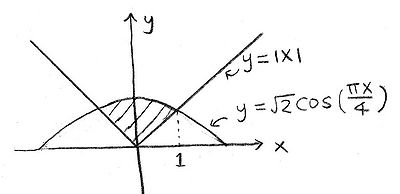Science:Math Exam Resources/Courses/MATH101/April 2014/Question 02
{{#incat:MER QGQ flag|{{#incat:MER QGH flag|{{#incat:MER QGS flag|}}}}}}
• Q1 (a) • Q1 (b) • Q1 (c) • Q1 (d) • Q1 (e) • Q1 (f) • Q1 (g) • Q1 (h) • Q1 (i) • Q1 (j) • Q1 (k) • Q2 • Q3 • Q4 • Q5 • Q6 • Q7 (a) • Q7 (b) • Q8 • Q9 (a) • Q9 (b) •
Question 02 |
|---|
|
Long Problem. Show your work. No credit will be given for the answer without the correct accompanying work. Find the area of the finite region bounded between the two curves and . It will be useful to sketch the region first. |
|
Make sure you understand the problem fully: What is the question asking you to do? Are there specific conditions or constraints that you should take note of? How will you know if your answer is correct from your work only? Can you rephrase the question in your own words in a way that makes sense to you? |
|
If you are stuck, check the hints below. Read the first one and consider it for a while. Does it give you a new idea on how to approach the problem? If so, try it! If after a while you are still stuck, go for the next hint. |
Hint 1 |
|---|
|
Where do the functions intersect? How does that help define the regions? |
Hint 2 |
|---|
|
How does the area for positive values compare to the area for negative values. |
|
Checking a solution serves two purposes: helping you if, after having used all the hints, you still are stuck on the problem; or if you have solved the problem and would like to check your work.
|
Solution 2 |
|---|
|
This solution doesn’t use the symmetry of the region. Find the intersection points. Since we have
by inspection, at , , so the first equality holds. Also, at , , so the second equality holds. Thus, the two graph intersect at .
|
{{#incat:MER CT flag||
}}
















![{\displaystyle {\begin{aligned}A_{+}=\int _{0}^{1}{\sqrt {2}}\cos({\frac {\pi x}{4}})-xdx=&\left[{\frac {4{\sqrt {2}}}{\pi }}\sin({\frac {\pi x}{4}})-{\frac {x^{2}}{2}}\right]_{x=0}^{x=1}\\=&{\frac {4}{\pi }}\cdot {\sqrt {2}}\cdot {\frac {1}{\sqrt {2}}}-{\frac {1}{2}}\\=&{\frac {4}{\pi }}-{\frac {1}{2}}.\end{aligned}}}](https://wiki.ubc.ca/api/rest_v1/media/math/render/svg/6f33c01d4e754ff8008f3fbfe9408df53f6e3b65)





![{\displaystyle {\begin{aligned}{\text{Area}}&=\int _{-1}^{1}{\sqrt {2}}\cos({\frac {\pi x}{4}})-|x|dx\\&=\int _{-1}^{0}{\sqrt {2}}\cos({\frac {\pi x}{4}})-|x|dx+\int _{0}^{1}{\sqrt {2}}\cos({\frac {\pi x}{4}})-|x|dx\\&=\int _{-1}^{0}{\sqrt {2}}\cos({\frac {\pi x}{4}})+xdx+\int _{0}^{1}{\sqrt {2}}\cos({\frac {\pi x}{4}})-xdx\\&=\left[{\frac {4{\sqrt {2}}}{\pi }}\sin({\frac {\pi x}{4}})+{\frac {x^{2}}{2}}\right]_{x=-1}^{x=0}+\left[{\frac {4{\sqrt {2}}}{\pi }}\sin({\frac {\pi x}{4}})-{\frac {x^{2}}{2}}\right]_{x=0}^{x=1}\\&={\frac {4}{\pi }}\cdot {\sqrt {2}}\cdot {\frac {1}{\sqrt {2}}}-{\frac {1}{2}}+{\frac {4}{\pi }}\cdot {\sqrt {2}}\cdot {\frac {1}{\sqrt {2}}}-{\frac {1}{2}}\\&={\frac {8}{\pi }}-1.\end{aligned}}}](https://wiki.ubc.ca/api/rest_v1/media/math/render/svg/53e62c2f9d92b41fea8e20416ebbf8cf0926cc18)
